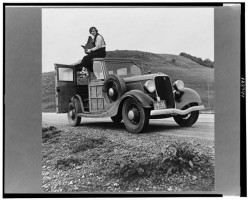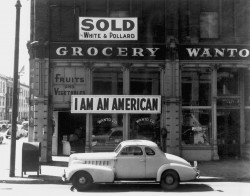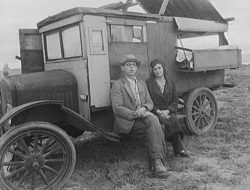
Daughter of Migrant Tennessee Coal Miner Living in American River Camp near Sacramento, California
(1936) by Dorothea Lange Credit: Gift of the Farm Security AdministrationMoMA Number:313.1938 Source: Museum of Modern Art
Dorothea Lange was born on May 26, 1895, in Hoboken,NJ. (2015 post; updated 5/26/2020)
Best known for her photographs of Depression-era America, she also recorded the the internment of Japanese-Americans during World War II.
Lange’s commitment to social justice and her faith in the power of photography remained constant throughout her life. In 1942, with the United States recently entered into World War II, the government’s War Relocation Authority assigned her to document the wartime internment of Japanese Americans, a policy she strongly opposed. She made critical images, which the government suppressed for the duration of the war.
–Dorothea Lange biographical entry from Museum of Modern Art

Photo by Dorothea Lange of Japanese-American grocery store on the day after Pearl Harbor Source: Library of Congress
Following the December 7, 1941 attack on Pearl Harbor by Japan, there was a wave of fear and hysteria aimed at Japanese and people of Japanese descent living in America, including American citizens, mostly on the West Coast. In February 1942. President Franklin D. Roosevelt issued Executive Order 9066 which declared certain areas to be “exclusion zones” from which the military could remove anyone for security reasons. It provided the legal groundwork for the eventual relocation of approximately 120,000 people to a variety of detention centers around the country, the largest forced relocation in American history. Nearly two-thirds of them were American citizens. (Smaller numbers of Americans of German and Italian descent were also detained.)
The attitude of many Americans at the time was expressed in a Los Angeles Times editorial of the period:
“A viper is nonetheless a viper wherever the egg is hatched… So, a Japanese American born of Japanese parents, nurtured upon Japanese traditions, living in a transplanted Japanese atmosphere… notwithstanding his nominal brand of accidental citizenship almost inevitably and with the rarest exceptions grows up to be a Japanese, and not an American…” (Source: Impounded, p. 53)
The exclusion order was rescinded in 1945 and internees were allowed to leave, although many had lost their homes, businesses and property during their confinement. However, the last camp did not close until 1946.
In 1980, Congress established the Commission on Wartime Relocation and Internment of Civilians to investigate the internment and, in 1988, President Reagan signed the Civil Liberties Act of 1988 which provided for a reparation of $20,000 to surviving detainees.
One of those detainees was Albert Kurihara who told the Commission on Wartime Relocation and Internment of Civilians in 1981:
“I hope this country will never forget what happened, and do what it can to make sure that future generations will never forget.” (from Impounded, Norton)
Photographer Dorothea Lange also photographed the internment camps and her censored images were published in 2006 in the book Impounded: Dorothea Lange and the Censored Images of Japanese American Internment (WW Norton, 2006).
The National Parks Service offers a Teaching With Historic Places lesson plan based on the camps some of which are now part of the National Parks System including Minidoka in Idaho and the Manzanar camp in California.
The Library of Congress offers an extensive collection of Lange photographs.

“Pea pickers in California. ‘Mam, I’ve picked peas from Calipatria to Ukiah. This life is simplicity boiled down.'” March, 1936. America from the Great Depression to World War II: Black-and-White Photographs from the FSA-OWI, 1935-1945, Library of Congress.